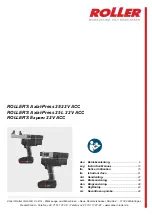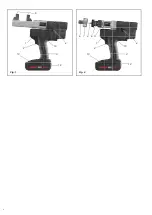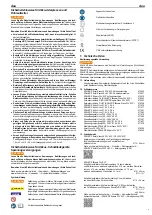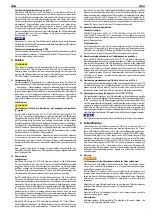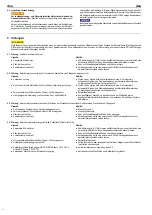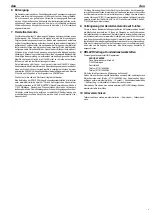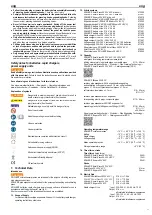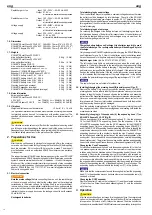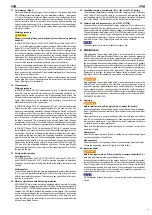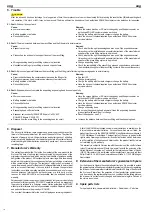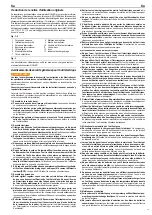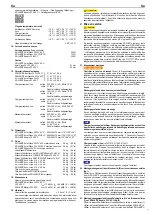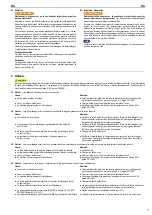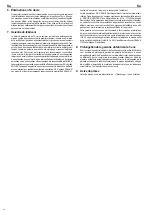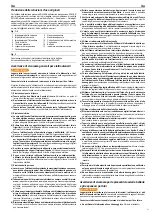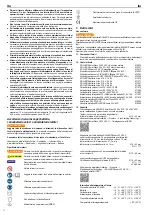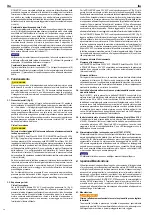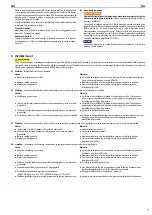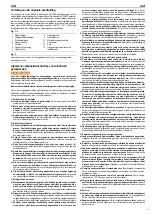
eng eng
3.1. Axial presses (Figs. 1)
11
Note the different working range of the axial presses. The respectively latest
ROLLER sales literature applies, see also
ROLLER
ROLLER
www.albert-roller.de → Downloads
→ Product Catalogues, Brochures. Make sure that the pressing heads (
→ Product Catalogues, Brochures. Make sure that the pressing heads (5) are
55
inserted into the drive unit in such a way that the pressing can be made in one
stroke if possible. This is not possible in some cases and pre-pressing and
fi nish pressing is necessary. For this, one pressing head or both pressing heads
must be inserted turned 180° before the second pressing process so that they
are closer together.
Working procedure
CAUTION
CAUTION
Danger of cru shing! Keep your hands away from the moving pressing
heads (5)!
In ROLLER’S Axial-Press 25 22 V ACC, ROLLER’S Axial-Press 25 L 22 V ACC
(Fig. 1), place the preassembled compression sleeve fi tting inside the pressing
heads (5). On the ROLLER’S Axial-Press 25 L ACC the closer distance of the
pressing heads may have to be achieved by moving the outer pressing head
into the centre pressing head position. Hold the drive machine either with one
hand on the switch handle (3) or two hands on the housing handle (1) and the
switch handle (3). Keep the safety inching switch (2) pressed until the compres-
sion sleeve is touching the collar of the compression sleeve connector. The
drive machine then switches automatically to return (forced return).
If there is a noticeable gap between the compression sleeve and the collar of
the compression sleeve connector after closing the compression heads, the
pressing may be faulty or leaking (see 5. Faults). Read and observe the instal-
lation and assembly instructions of the manufacturer/supplier of the pressing
sleeve system to be pressed.
With the compression sleeve system IV, various pressing heads are needed
for one pipe size. Consult and comply with the instructions for installation and
fi tting of the system’s manufacturer.
3.2. Pipe expanders
Working procedure
In ROLLER’S Exparo 22 V ACC with expander Cu (Fig. 2), insert the expanding
head into the pipe up to the stop and press the expanding head/drive unit
against the pipe. Switch on the drive unit. If the expanding head is open, the
drive unit switches automatically to return and the expanding head is closed
again. Read and observe the installation and assembly instructions of the
manufacturer/supplier of the used system.
In ROLLER’S Exparo 22 V ACC with expander P (Fig. 2), push the compression
sleeve over the pipe, insert the expanding head into the pipe up to the stop
and press the expanding head/drive unit against the pipe. Switch on the drive
unit. Make sure that the compression sleeve is far enough away from the
expanding head in the expanding process because otherwise the expanding
jaws (8) can bend or break. Keep the safety inching switch (2) pressed until
the pipe is expanded. This is indicated by an acoustic signal (click). Expand
several times if necessary. Turn the pipe slightly. Read and observe the instal-
lation and assembly instructions of the manufacturer/supplier of the used system.
In ROLLER’S Exparo 22 V ACC with expander P-CEF (Fig. 2), read and observe
the installation and assembly instructions of the manufacturer/supplier of the
used system. Push a ring of the appropriate size onto the pipe.Insert the expan-
sion head into the pipe and press the expanding head/drive unit against the
pipe. Switch on the drive unit. When the expanding head is opened, the drive
unit switches automatically to return and the expanding head is closed again.
Keep holding the safety inching switch (2) down in the ROLLER’S Exparo 22 V
ACC and push the expanding head/drive unit further. Turn the pipe slightly.
Keep repeating the expansion process until the expanding jaws (8) are slid all
the way into the pipe.
the way into t
the way into t
3.3. Safety during operation
Functional safety
ROLLER’S Axial-Press 25 22 V ACC, ROLLER’S Axial-Press 25 L 22 V ACC
and ROLLER’S Exparo 22 V ACC end the pressing operation automatically,
emitting an acoustic signal (clicking) and return automatically (automatic circuit
control).
Working safety
To ensure safe working, the drive units are equipped with a safety inching switch
(2). This permits immediate switching off of the drive units at any time, parti-
cularly if a potential hazard arises. The drive units can be switched to the return
function in any position.
3.4. Machine status check with fl at battery protection
All ROLLER’S Akku presses have been equipped with an electronic machine
status check with charging level indicator (10) with a 2-coloured green/red LED
since 01/01/2011. The LED lights green when the battery is fully or still suffi ciently
charged. The LED lights red when the battery must be charged. If this condition
occurs during pressing and the pressing process is not fi nished, the pressing
must be completed with a fully charged Li-Ion battery. If the drive unit is not
used, the LED goes out after approx. 2 hours but comes on again when the
drive unit is switched back on.
3.5. Graduated charging level indicator (13) of the Li-Ion 21.6 V battery
The graduated charging level indicator shows the charging level of the battery
The graduated charging level indicator show
The graduated charging level indicator show
with 4 LEDs. At least one LED lights for a few seconds after pressing the key
with the battery symbol. The more LEDs that light green, the higher the charging
level of the battery. If a LED fl ashes red, the bat
level of the battery. If a LED fl ashes
level of the battery. If a LED fl ashes
tery must be recharged.
3.6. Power supply unit (accessory art. no. 571567, 571578)
571567, 571578
571567, 571578
The power supply units are intended for mains operation of the cordless tools in
place of the battery. See the guidelines for use (Fig. 5) for the intended use. The
55
power supply units are equipped with overvoltage and temperature protection.
The operating state is indicated by a LED. A lit LED indicates that the device is
ready for operation. If the LED goes out or fl ashes, this indicates an overcurrent
or impermissible temperature. The drive unit cannot be used during this time.
After a dwell time, the LED lights again and work can be continued.
NOTICE
The power supply units are not suitable for outdoor use.
4. Maintenance
Notwithstanding the servicing listed below it is recommended to send in the
ROLLER’S drive units together with all the tools (e.g. pressing heads, expanding
heads) and accessories (e.g. batteries, rapid chargers, power supply units) at
least once a year to an authorised ROLLER customer service station for inspec-
tion and repeated inspection of electrical equipment. In Germany, such periodic
testing of electrical devices should be performed in accordance with DIN VDE
0701-0702 and also prescribed for mobile electrical equipment according to
the accident prevention rules DGUV, regulation 3 "Electrical Systems and
Equipment". In addition, the respective national safety provisions, rules and
regulations valid for the application site must be considered and observed.
WARNING
WARNING
Notwithstanding the servicing listed below it is recommended to send in the
ROLLER drive units together with all the tools (e.g. pressing tongs, pressing
tongs Mini, pressing rings with adapter tongs, adapter tongs Mini, compression
heads, expanding heads) and accessories (e.g. batteries, rapid chargers) at
least once a year to an authorised ROLLER customer service station for inspec-
tion and repeated inspection of electrical equipment in accordance with EN
62638:2010-08 (VDE 0702).
4.1. Servicing
WARNING
WARNING
Before service work, pull the mains plug or remove the battery!
Keep pressing heads and expanding heads, and particularly their receptacles,
clean. Clean heavily soiled metal parts with machine cleaner and then protect
against rust.
Clean plastic parts (e.g. housing, batteries) only with a mild soap and a damp
cloth. Do not use domestic cleaning agents. These frequently contain chemicals
that can attack plastic parts. On no account use petrol, turpentine oil, thinners
or similar products to clean plastic parts.
Make sure that liquids never get inside the power tool. Never immerse the
power tool in liquid.
Axial presses
Keep the compression heads (5) and mounting bores in the pressing device
and the pressing device itself clean.
Pipe expanders
Keep the expander (6), expanding heads (7) and expanding mandrel (9) clean.
Grease the expanding mandrel (9) lightly from time to time.
4.2. Inspection/repair
WARNING
WARNING
Before any repair work, pull the mains plug or remove the battery! This
Before any repair work, pull the mains plug or remove the battery!
Before any repair work, pull the mains plug or remove the battery!
work may only be performed by qualifi ed personnel.
In the battery-operated drive units, the carbon brushes of the motor are subject
to wear. These cannot be replaced; the DC motor must be replaced. The sealing
rings (O-rings) wear in all electro-hydraulic drive units. These must therefore
be checked and renewed from time to time. If the pressing power is insuffi cient
or oil is lost, the drive unit must be inspected and if necessary repaired by an
authorised ROLLER customer service station.
NOTICE
Do not attempt to repair damaged or worn pressing heads and expanding
heads.
13
Summary of Contents for Axial-Press 25 22 V ACC
Page 2: ...Fig 2 Fig 1 13 13 2 2 4 4 12 12 10 10 3 3 1 1 6 11 9 7 8 5 2...
Page 53: ...53...
Page 54: ...54...
Page 55: ...55...

